Have you ever wondered why your dog licks your cat? It turns out, there’s a lot more to this behavior than meets the eye. Dogs licking cats is a common occurrence and can be a fascinating insight into their behavior and relationship dynamics. By understanding the reasons behind this behavior, you can strengthen the bond between your furry friends and ensure a harmonious coexistence.
When dogs lick cats, it can signify various things. It can be a way for your dog to communicate with the cat, establish social bonds, or seek attention. Dogs also have an instinctual grooming behavior, and licking can be a part of that. But it’s essential to pay attention to their interactions and ensure that both pets are comfortable and happy with the behavior.
Key Takeaways:
- Dogs lick cats as a form of communication and to establish social bonds.
- Licking can be a sign of affection, submission, or a desire for attention.
- It is important to monitor their interactions and ensure a positive relationship.
- Dogs may lick cats to alleviate stress or seek attention.
- Understanding the reasons behind dog licking can help strengthen the bond between dogs and cats.
Why Do Dogs Lick?
Dogs engage in licking behaviors for various reasons, which can shed light on their behavior and emotions. Understanding the motivations behind dog licking can help us strengthen our bond with them and ensure their well-being. Let’s explore some of the common reasons why dogs lick:
Expressing Affection and Bonding
Licking is a natural way for dogs to show affection and strengthen their bond with humans and other animals. When a dog licks you, it’s their way of expressing love and care. This behavior releases endorphins that provide a sense of comfort and well-being for both the dog and the recipient of the licking.
Maintaining Cleanliness
Dogs have a natural instinct to groom themselves and others, including fellow animals. Licking helps them keep their fur clean and free from dirt, debris, and loose hairs. When dogs lick themselves or their companions, it is a grooming behavior that promotes hygiene and can also serve as a bonding experience.
“Licking is a way for dogs to communicate, show affection, and establish social bonds.”
Seeking Attention and Interaction
Dogs may lick as a way to seek attention and initiate social interaction. It can be their way of saying, “I want to play” or “I need your attention.” By licking, dogs are inviting us to engage with them and respond to their needs, whether it’s through playtime, cuddles, or simply acknowledging their presence.
| Reasons for Dog Licking | Description |
|---|---|
| Expressing affection and bonding | Dogs lick to show love and strengthen their connection with humans and other animals. |
| Maintaining cleanliness | Licking helps dogs groom themselves and keep their fur clean and free from dirt. |
| Seeking attention and interaction | Dogs lick to initiate social interaction and communicate their needs to their human companions. |
Understanding why dogs lick is essential for building a strong and harmonious relationship with our furry friends. It allows us to respond appropriately to their needs and reinforce the bond we share. However, if excessive licking becomes a concern or causes discomfort, it’s important to consult with a veterinarian to rule out any underlying medical issues or address any behavioral problems.
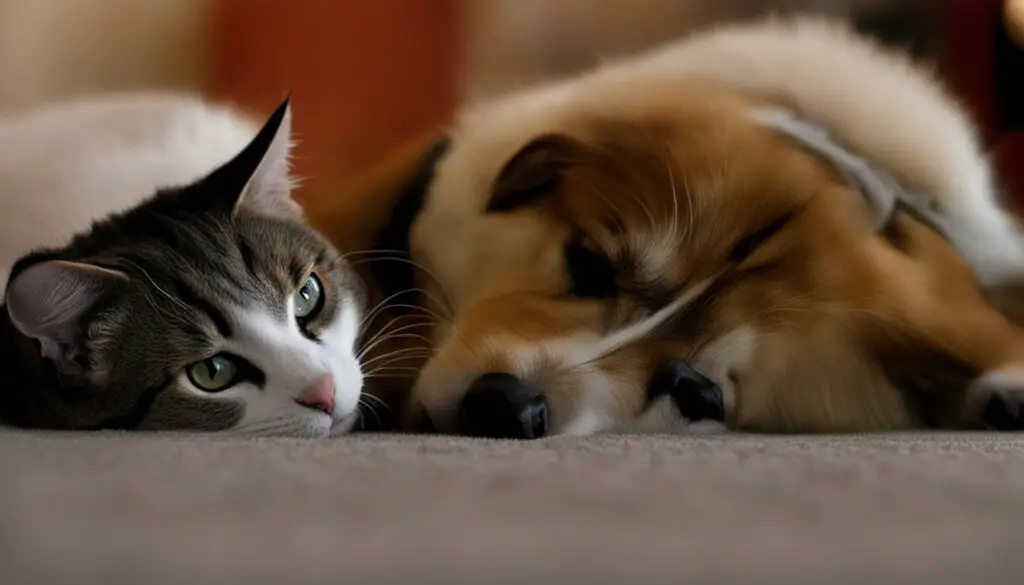
Communication: Dogs Lick to Communicate
Communication plays a vital role in a dog’s interactions with humans and other animals. Dogs have a unique way of expressing themselves, and licking is one of their primary forms of communication. When dogs lick, it serves as a gesture to convey a variety of messages to those around them.
Licking is a form of greeting for dogs, similar to a handshake for humans. It is their way of saying hello and establishing a connection with other dogs or their owners. Dogs may also lick as a sign of submission, indicating that they recognize the authority or dominance of another individual.
In addition to greetings and submission, dogs may lick as a way of seeking attention or expressing their needs. By licking their owners, dogs can indicate that they desire affection, playtime, or food. It is their way of communicating their wants and ensuring that their needs are met. Dogs may also lick to elicit a response from their owners or to convey their love and affection.
Understanding the reasons behind dog licking can help pet owners interpret their dog’s actions and strengthen their bond. It is important to pay attention to the context in which the licking occurs and to observe other body language cues to fully understand the message being conveyed by the dog.
| Reasons Why Dogs Lick | Description |
|---|---|
| Greeting | Dogs use licking as a way of saying hello and establishing social bonds. |
| Submission | Licking can be a sign of respect and submission towards individuals of higher authority or dominance. |
| Attention-Seeking | Dogs may lick their owners to indicate that they want attention, playtime, or food. |
| Affection | Licking is a way for dogs to express their love and affection towards their owners and other animals. |
Dog licking is an essential part of their communication repertoire, and by understanding its significance, pet owners can better respond to their dogs’ needs and strengthen the bond between them.
Grooming: Dogs Lick for Grooming Purposes
When it comes to grooming, dogs have a natural instinct to keep themselves and others clean. Licking is one of the ways dogs groom themselves and those around them, including cats. Dogs use their tongues to remove dirt, debris, and loose hairs from their fur, promoting hygiene and maintaining a clean coat.
Aside from personal grooming, dogs engage in grooming behaviors with other animals as a bonding activity. When a dog licks a cat, it is not only about cleanliness but also about strengthening their relationship. Grooming rituals between dogs and cats help build trust and establish social bonds between the two species.
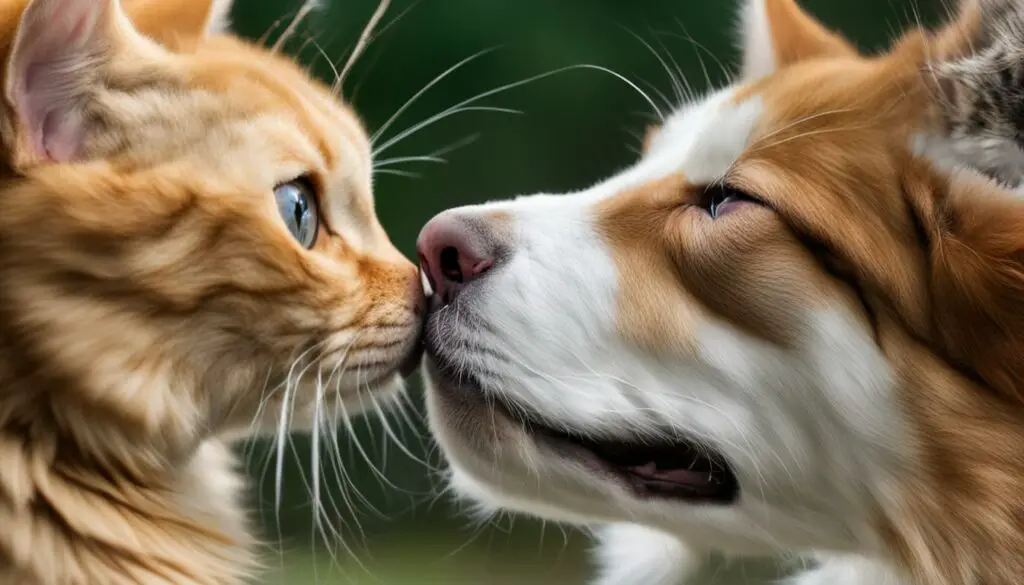
Canine Grooming Instincts
Canine grooming instincts are deeply ingrained in their nature. Dogs have a strong desire to groom themselves and others, driven by their pack mentality and the need to maintain a sense of unity within their social group, whether it be with other dogs or cats.
Grooming can also be a comforting and soothing behavior for dogs. It helps them reduce stress and promote relaxation. This is particularly evident in mother dogs who groom their puppies as a way to care for and bond with them. The act of grooming releases endorphins in dogs, creating a sense of well-being and contentment. It reinforces positive emotions and strengthens the bond between dogs and cats.
Table:
| Grooming Behaviors | Description |
|---|---|
| Grooming self | Dogs groom themselves to remove dirt, debris, and loose hair from their fur. |
| Grooming others | Dogs groom other animals, including cats, as a bonding activity and to strengthen their social bonds. |
| Grooming as a soothing behavior | Grooming helps dogs reduce stress, promotes relaxation, and releases endorphins that create a sense of well-being. |
| Grooming in mother dogs | Mother dogs groom their puppies as an act of caregiving, promoting bonding and providing comfort. |
Overall, grooming is an essential behavior for dogs. When they lick cats, it not only serves a grooming purpose but also acts as a social bonding activity. Understanding dogs’ grooming instincts and the role it plays in their relationship with cats can help pet owners foster a positive and harmonious environment for both animals.
Affection: Dogs Lick to Show Affection
When it comes to dogs, licking is not just a behavior, but a way to express their affection and love for their human companions. Dogs use licking as a form of communication and bonding, and it is one of the ways they show their affection towards us. While it may seem slobbery and messy at times, this gesture holds deep meaning for dogs.
Canine bonding gestures such as licking can release endorphins in dogs, creating a sense of well-being and happiness. It is their way of showing us that they care and love us. The act of licking also serves as a way for dogs to seek attention and initiate interaction with their owners. They may lick our hands, face, or even our feet to show their affection and to communicate their needs.
“A dog is the only thing on earth that loves you more than he loves himself.” – Josh Billings
In addition to expressing love, dogs also lick as a way to strengthen their bond with us. It is a behavior deeply ingrained in their instincts, as it is reminiscent of how a mother dog grooms and cares for her puppies. By licking us, dogs are reaffirming their connection with us, as if to say, “You are a part of my pack, and I love you.”
| Signs of Dog Love: | Meaning: |
|---|---|
| Excessive licking | Expressing deep affection and love |
| Licking your face | Seeking attention and initiating play |
| Licking your hands or feet | Bonding and establishing social connection |
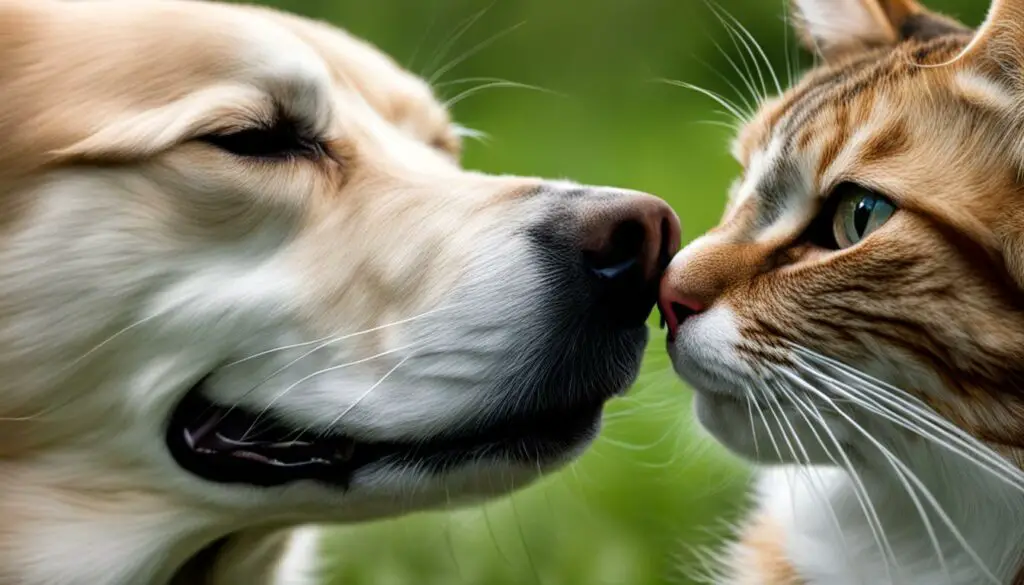
Understanding the meaning behind a dog’s licking behavior can help us appreciate their affectionate gestures. However, it is important to set boundaries and redirect the behavior if it becomes excessive or unwanted. Consistency in training and positive reinforcement can help guide our dogs to express their love and affection in appropriate ways.
Why Does My Dog Lick My Cat?
It is not uncommon for dogs to lick cats as part of their behavior and interaction. There are several reasons why dogs engage in this behavior, which can shed light on their relationship with their feline companions. Dogs may lick cats to strengthen their bond, establish dominance or submission, seek attention, or alleviate stress. Understanding these reasons can help pet owners create a positive environment for both pets and ensure a harmonious relationship between them.
Dogs and cats can form strong bonds, and licking is one way for dogs to strengthen their relationship with their feline companions. It can be seen as a sign of affection and bonding between the two animals. Dogs may also lick cats as a form of dominance or submission in the animal hierarchy. By licking, dogs assert their position or show respect to higher-ranking cats. It is important to observe their body language and behavior to fully understand the context of this behavior.
Another reason why dogs lick cats is to seek attention. Licking can be a way for dogs to get the cat’s attention or to alleviate stress. Dogs may use licking as a coping mechanism in stressful situations, creating a soothing and calming experience for both animals. However, it is essential to monitor their interactions closely and consider the cat’s response. Some cats may tolerate or even enjoy dog licking, while others may find it irritating or stressful. Ensuring the well-being of both animals should be the top priority.
| Reasons Why Dogs Lick Cats | Description |
|---|---|
| Bonding | Dogs lick cats as a way to strengthen their bond and show affection. |
| Dominance/Submission | Dogs may lick cats to establish their position in the animal hierarchy or show respect to higher-ranking cats. |
| Attention Seeking | Dogs lick cats to get their attention or alleviate stress. |
| Stress Relief | Licking can be a way for dogs to cope with stress and create a calming experience for both animals. |
Monitoring their interactions and addressing any concerns that arise is crucial in creating a positive and harmonious environment for both pets. By understanding the reasons behind dog licking and being attentive to their behavior, pet owners can foster a strong bond between their dog and cat and ensure their well-being.
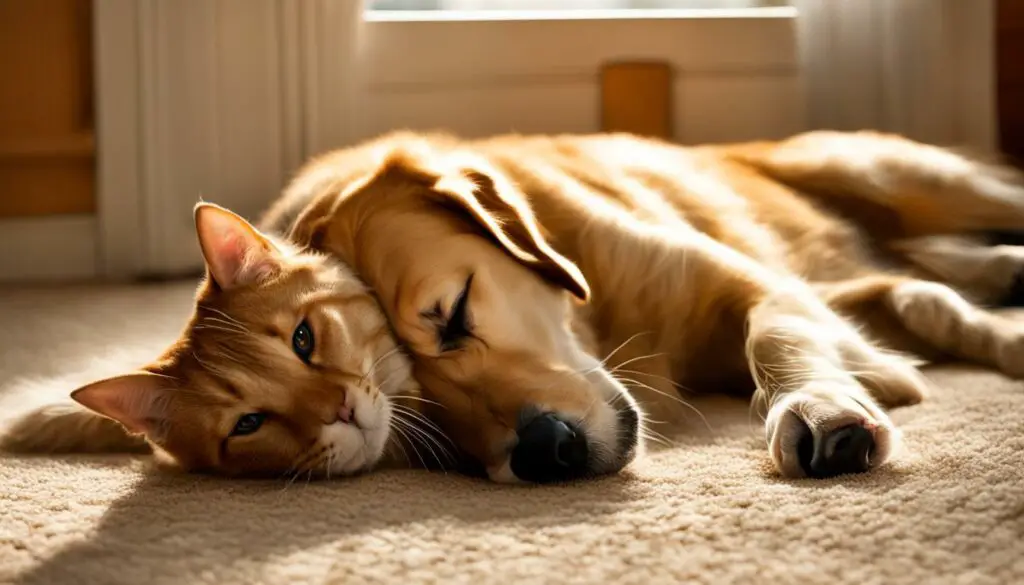
Dogs Lick Cats to Strengthen Bonds
When dogs lick cats, it is not just a random behavior; it serves a purpose. One of the main reasons why dogs lick cats is to strengthen their social bonds. Licking is a way for dogs to express their affection and care for their feline companions. It is a form of communication that helps establish trust and a sense of belonging within the social group.
Through licking, dogs and cats can create a positive and harmonious relationship. It initiates and sustains social interactions between them, promoting a strong and lasting bond. Licking is a natural behavior that dogs use to show their love and reinforce their connection with cats. It is their way of saying, “You are part of my pack, and I care about you.”
In addition to social bonding, dogs may also lick cats as a means of stress relief. Licking has a calming effect on dogs, releasing endorphins that promote relaxation. By licking cats, dogs create a calm environment for both animals, reducing anxiety and tension. It is a soothing behavior that dogs use to create a sense of comfort and well-being.
| Dog and Cat Social Bonding | Strengthening the Bond Between Dog and Cat | Dog and Cat Relationship |
|---|---|---|
| Dogs lick cats to establish trust and a sense of belonging. | Licking helps create a positive and harmonious relationship. | Dogs and cats form a strong bond through licking and social interactions. |
| Licking is a way for dogs to express their affection towards cats. | It reinforces the connection and love between them. | Dogs consider cats as part of their pack and care for them. |
| Licking provides stress relief for both dogs and cats. | It creates a calm environment and reduces anxiety. | Dogs use licking as a soothing behavior to comfort cats. |
Overall, dog licking is a natural behavior that serves multiple purposes, including social bonding and stress relief. By understanding the reasons behind dog licking and monitoring their interactions, pet owners can ensure a positive and harmonious relationship between their dogs and cats. Remember to provide a safe and comfortable environment for both animals, and seek professional guidance if necessary to address any concerns.
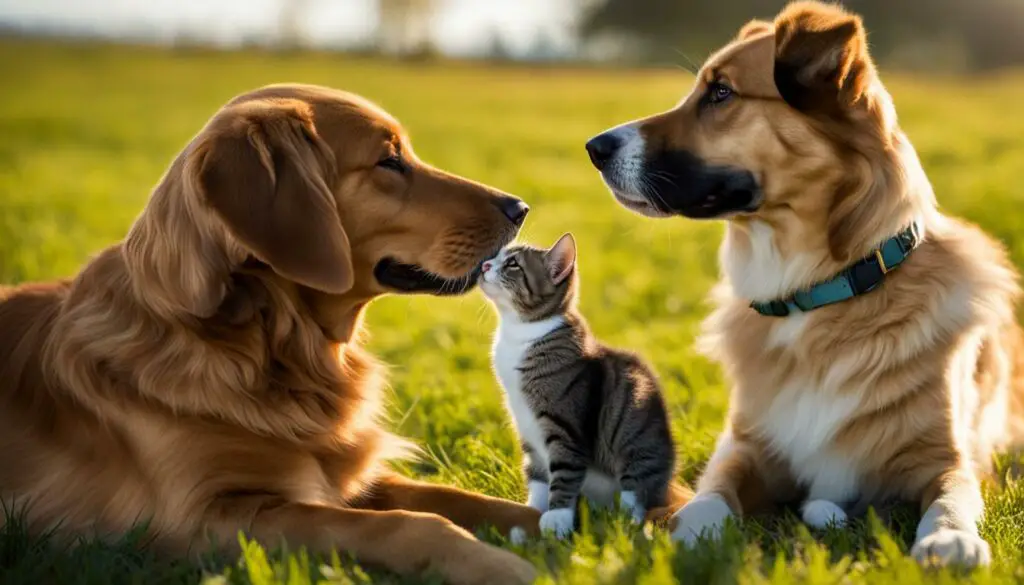
Dominance/Submission: Dogs Lick Cats to Establish Hierarchy
Dogs licking cats can be a display of dominance or submission in the animal hierarchy. When a dog licks a cat, it can be a sign of asserting dominance or showing respect to higher-ranking cats. This behavior is a part of their natural communication and social dynamics.
To understand the context of dog licking, it is important to observe their body language and behavior. Dogs may lick cats as a way to establish their position in the social group. On the other hand, dogs may also lick cats as a form of submission, acknowledging the cat’s higher status.
If you notice your dog licking your cat, it is crucial to pay attention to both animals’ comfort levels. Some cats may tolerate or even enjoy the licking, while others may find it irritating or stressful. It’s important to create a safe and harmonious environment for both pets, ensuring the well-being of all involved.
To better understand the dynamics between dogs and cats and address any concerns about dominance/submission behaviors, it is advisable to consult with a professional dog trainer or animal behaviorist. They can provide guidance on managing and modifying these behaviors, promoting a positive relationship between your dog and cat.
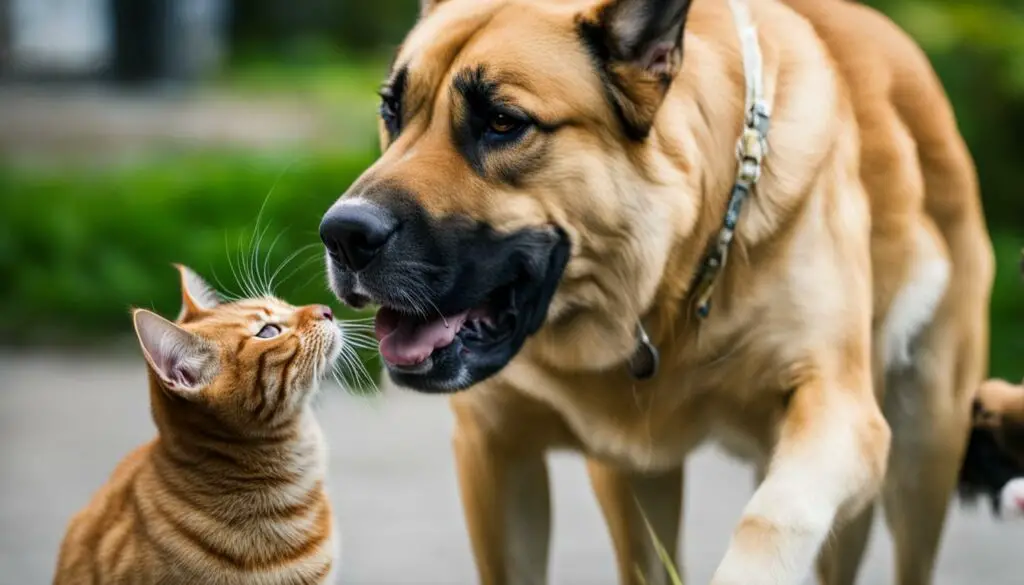
Stress Relief: Dogs Lick Cats to Alleviate Stress
Dogs may engage in licking cats as a way to alleviate stress. Licking has a calming effect on dogs, releasing endorphins that promote relaxation. It is a soothing behavior that can help dogs cope with anxiety and create a sense of comfort in stressful situations.
Licking is a natural instinct for dogs, and it can serve as a form of self-soothing. By licking, dogs can redirect their focus and release tension, effectively reducing stress levels. This behavior can not only benefit the dogs themselves but also create a calming environment for the cats they interact with.
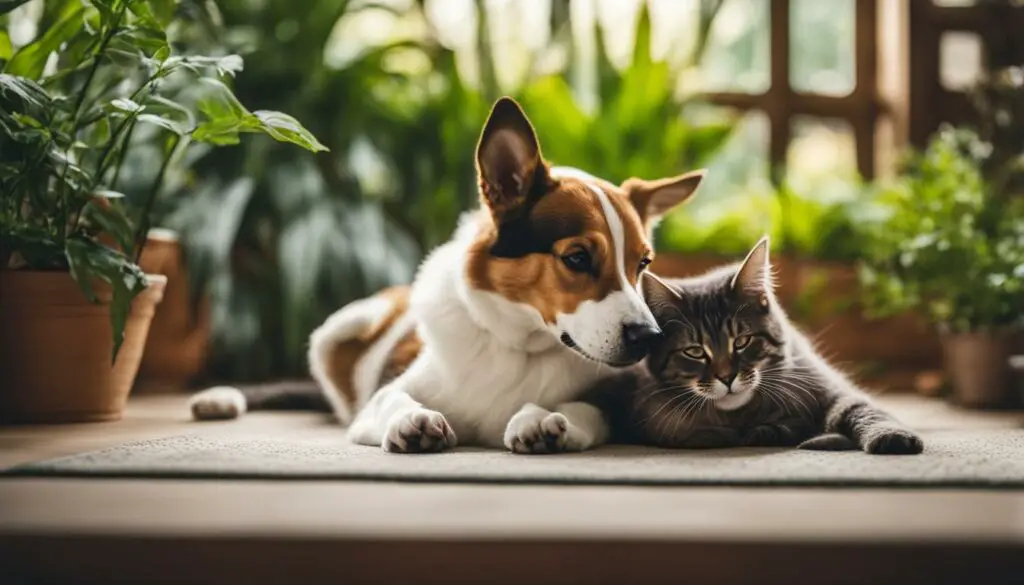
It is important to note that excessive licking should be monitored and addressed. While licking can be a healthy coping mechanism, it may become a concern if it persists or causes discomfort to the cat. Consulting with a veterinarian can help rule out any underlying medical issues and ensure the well-being of both animals.
By understanding the soothing nature of dog licking and taking appropriate measures to manage it, pet owners can create a harmonious environment that promotes stress relief for both dogs and cats.
Monitoring Interactions: Ensuring a Positive Relationship
It is essential for pet owners to monitor the interactions between dogs and cats to ensure a positive relationship. By observing their behavior and understanding their cues, we can promote a harmonious coexistence and foster a strong bond between them. When dogs lick cats, it is important to consider the cat’s reaction. Some cats may tolerate or even enjoy the licking, while others may find it irritating or stressful.
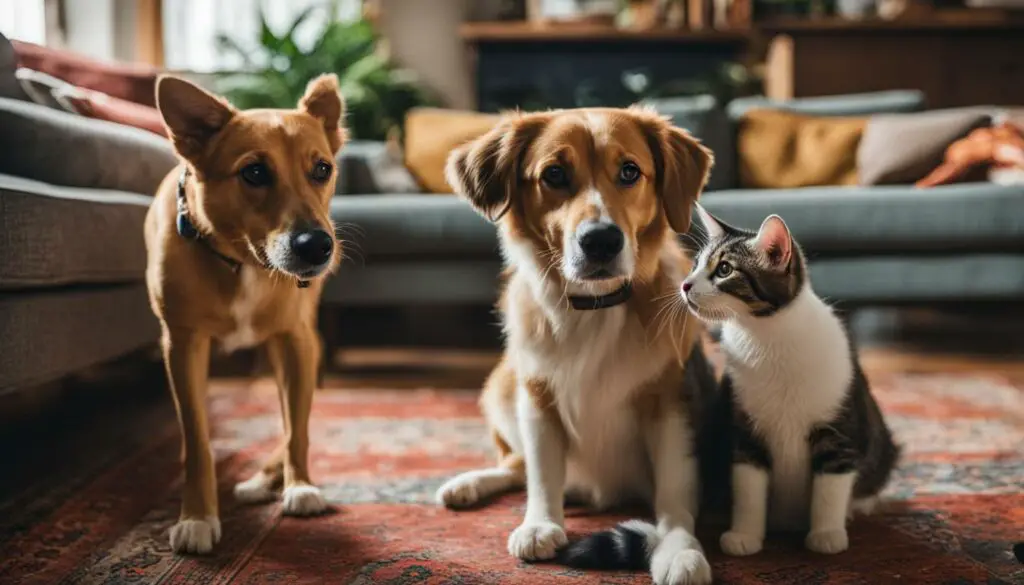
Defensive behaviors by cats, such as hissing or swatting, may indicate fear or anxiety. To create a safe environment, it is crucial to provide a space where both animals feel comfortable and respected. If the cat’s discomfort becomes evident or the licking becomes excessive, it may be necessary to intervene and redirect the behavior. This can be achieved through positive reinforcement training or seeking professional guidance from a veterinarian or animal behaviorist.
Creating a Harmonious Environment
To ensure a positive relationship between dogs and cats, it is important to establish boundaries and provide adequate resources for both pets. This includes separate feeding areas, litter boxes, and resting spaces. Dogs should be taught to respect the cat’s personal space and not to overwhelm them with excessive licking or rough play. Additionally, regular exercise and mental stimulation for both pets can help reduce stress and create a calm environment.
By actively monitoring their interactions, addressing any concerns, and providing proper care, pet owners can cultivate a strong and healthy relationship between their dog and cat. Remember that each animal is unique, and it is essential to understand their individual needs and preferences. With patience, love, and respect, dogs and cats can form a lasting bond that brings joy and companionship to both pets and their owners.
Strategies to Manage Dog Licking Behaviors
Managing dog licking behaviors involves redirecting their attention and providing alternative outlets for their natural instincts. Here are some strategies to help you manage your dog’s licking behavior:
1. Provide Mental and Physical Stimulation
Dogs often lick when they are bored or need stimulation. Keeping your dog mentally and physically engaged can help distract them from excessive licking. Provide interactive toys, puzzle feeders, and plenty of exercise to keep their mind and body occupied.
2. Teach a “Leave It” or “No Lick” Command
Training your dog to respond to commands like “leave it” or “no lick” can be effective in redirecting their licking behavior. Consistently reinforce these commands and reward your dog with treats or praise when they comply. With time and practice, they will learn to refrain from licking when given the cue.
3. Use Bitter Tasting Deterrents
Applying bitter-tasting deterrents, specifically formulated for pets, on surfaces or objects that your dog tends to lick can discourage them from engaging in the behavior. The unpleasant taste will deter them from licking and redirect their attention elsewhere.
4. Provide Distractions and Alternatives
Offer your dog alternative activities to engage in when they start licking. Provide chew toys, puzzle toys, or frozen treats to keep them occupied and prevent them from focusing on licking. Engaging their senses and providing mental stimulation can help redirect their urge to lick.
5. Consult a Professional Trainer or Behaviorist
If your dog’s licking behavior persists or becomes problematic, it may be beneficial to seek guidance from a professional dog trainer or behaviorist. They can assess the underlying causes of the behavior and provide tailored strategies to manage it effectively. They may also be able to identify any potential medical issues that could be contributing to the excessive licking.
By implementing these strategies and staying consistent with redirection and training efforts, you can effectively manage your dog’s licking behaviors and promote a healthier and happier relationship with your pet.
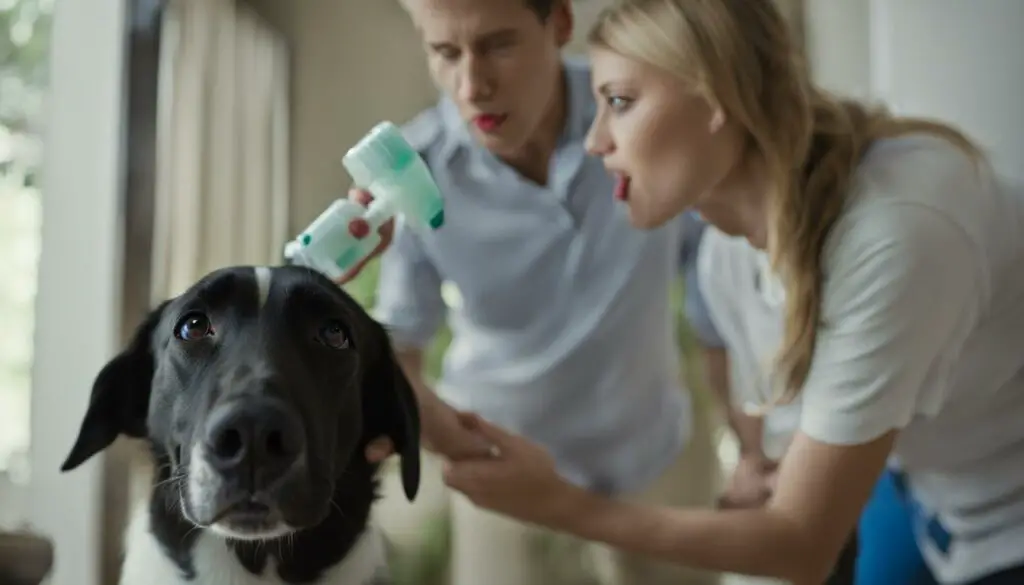
When Excessive Licking Becomes a Concern
Excessive dog licking can sometimes become a cause for concern, especially if it causes discomfort to the cat or persists despite redirection efforts. While dog licking is a normal behavior, there are instances where it may indicate underlying medical issues or behavioral problems that need to be addressed.
If you notice that your dog’s licking behavior is excessive and causing discomfort to the cat, it is advisable to consult with a veterinarian for further evaluation. The veterinarian can assess your dog’s overall health and rule out any medical issues that might be contributing to the excessive licking. They may also be able to provide guidance on behavior modification techniques or recommend a professional dog trainer or animal behaviorist to address any underlying behavioral issues.
Some medical issues that can cause excessive dog licking include allergies, skin infections, gastrointestinal issues, or pain. Identifying and treating these underlying conditions is essential in alleviating the excessive licking behavior and ensuring the well-being of both your dog and cat.
| Medical Issues Related to Dog Licking | Symptoms | Treatment |
|---|---|---|
| Allergies | Excessive scratching, redness, swelling, skin irritation | Allergy testing, medication, dietary changes |
| Skin Infections | Red or inflamed skin, hair loss, unusual odor | Antibiotics, medicated shampoos, topical treatments |
| Gastrointestinal Issues | Vomiting, diarrhea, gastrointestinal discomfort | Dietary changes, medication, addressing underlying condition |
| Pain | Limping, reluctance to move, sensitivity to touch | Veterinary consultation, pain management, addressing underlying cause |
Excessive dog licking can be a sign of underlying medical issues or behavioral problems. It is important to seek veterinary advice to rule out any potential health concerns and ensure the well-being of your pets.
Addressing excessive dog licking is crucial to create a harmonious environment for both animals. By identifying and addressing any medical issues or behavioral problems, you can help your dog and cat maintain a positive relationship and ensure their overall well-being.
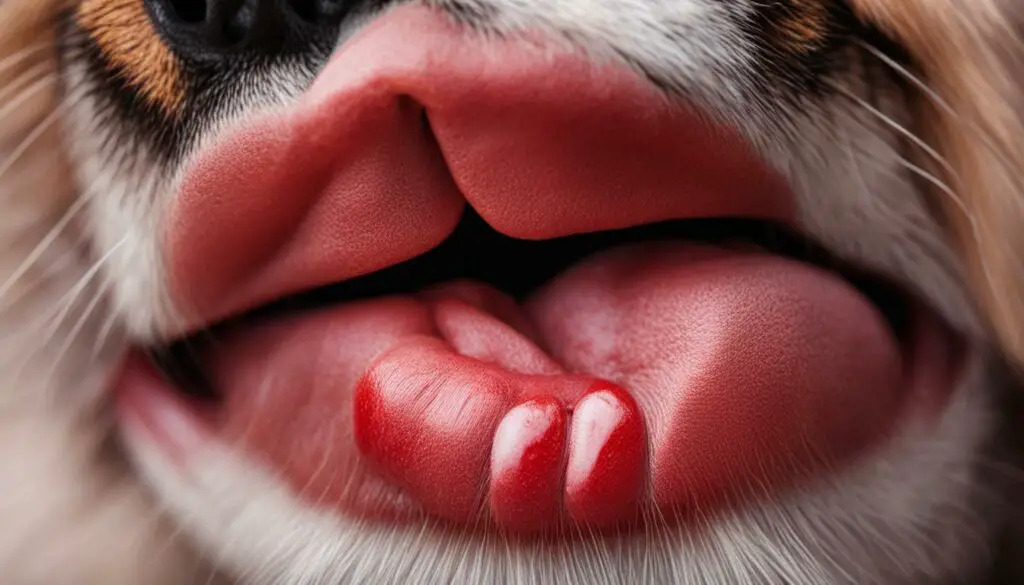
Common Medical Issues Related to Dog Licking:
- Allergies: Excessive scratching, redness, swelling, and skin irritation. Allergy testing, medication, and dietary changes may be necessary.
- Skin Infections: Red or inflamed skin, hair loss, and an unusual odor. Treatment typically involves antibiotics, medicated shampoos, and topical treatments.
- Gastrointestinal Issues: Vomiting, diarrhea, and gastrointestinal discomfort. Dietary changes, medication, and addressing the underlying condition may be required.
- Pain: Limping, reluctance to move, and sensitivity to touch. Veterinary consultation, pain management, and addressing the underlying cause are essential.
Canine Licking: A Normal Behavior
When it comes to dogs licking cats, it is important to understand that this behavior is considered normal in the context of their social interactions. Dogs use licking as a way to communicate, groom, and show affection to their feline companions. It is a natural part of their bonding process and can indicate a positive relationship between the two animals.
Dogs licking cats can serve various purposes. It can be a way for dogs to establish social bonds and strengthen their relationship with cats. Licking is also a grooming behavior that helps dogs maintain cleanliness and hygiene, both for themselves and for other animals. Additionally, licking is a display of affection from dogs towards their human companions and other animals in their social group.
However, it is essential to closely monitor the interactions between dogs and cats to ensure a harmonious coexistence. Cats may respond differently to dog licking, with some cats tolerating or even enjoying the behavior, while others may find it irritating or bothersome. Paying attention to the cat’s response and ensuring their well-being is crucial in maintaining a positive relationship between dogs and cats.
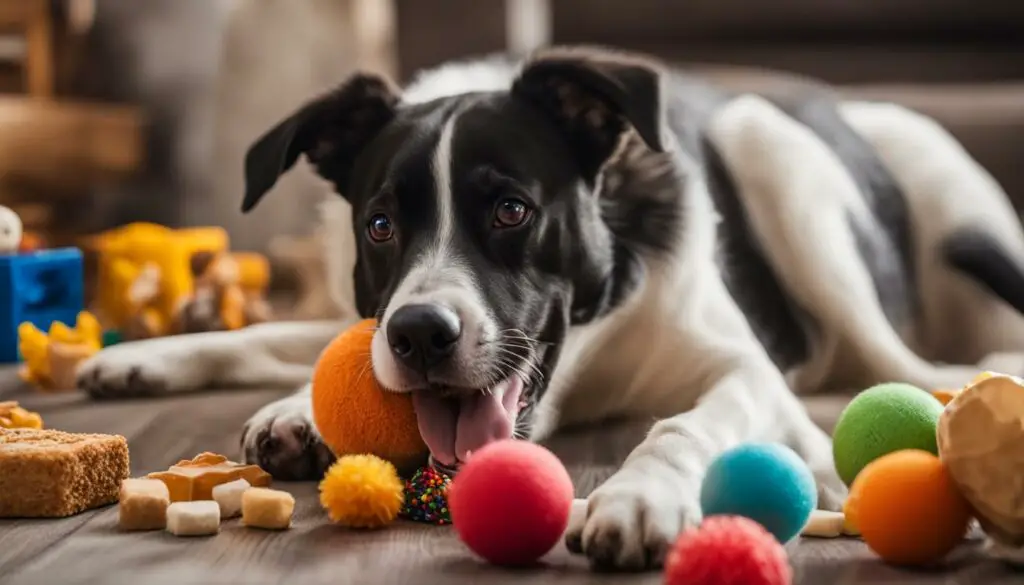
Key Points:
- Dog licking is a normal behavior in the context of their social interactions with cats.
- Licking serves as a way for dogs to communicate, groom, and show affection.
- Monitoring interactions is important to ensure the well-being of both dogs and cats.
Table: Differences in Dog Licking Behavior
| Behavior | Meaning |
|---|---|
| Licking the face | Sign of affection and bonding |
| Licking the paws or body | Grooming behavior for cleanliness |
| Excessive licking | Possible stress or anxiety indicator |
| Licking the ears or mouth | Seeking attention or play initiation |
Cats’ Reactions to Dog Licking
Cats can exhibit a range of reactions when dogs lick them. Some cats may tolerate and even enjoy the licking, viewing it as a form of grooming or affection from their canine companions. In these cases, the cat may reciprocate the behavior or allow the dog to continue licking without signs of discomfort. It’s important to note that cats have unique personalities, and their response to dog licking can vary.
On the other hand, some cats may find dog licking irritating or bothersome. They may attempt to move away or display signs of annoyance, such as hissing or swatting. These reactions can indicate that the cat is not comfortable with the licking behavior and may prefer to have their personal space respected.
In some situations, a cat’s negative reaction to dog licking may stem from fear or anxiety. Cats are known for their independent nature and may feel threatened or stressed by a dog’s persistent licking. It’s crucial to observe the cat’s body language and behavior to ensure their well-being and maintain a positive relationship between the two pets.
Understanding Cat Behavior
When considering a cat’s response to dog licking, it’s important to understand their unique behavior patterns. Cats are known for their grooming rituals, and they may have different preferences when it comes to receiving grooming from other animals. Some cats may enjoy being groomed by dogs, while others may prefer to groom themselves or receive grooming solely from their feline counterparts.
Additionally, cats have varying levels of tolerance for physical contact, including licking. While some cats may be more sociable and enjoy interaction with dogs, others may prefer a more independent and solitary lifestyle. Respecting each cat’s individual needs and preferences is essential for maintaining a harmonious environment with their canine companions.
Creating a Positive Relationship
To ensure a positive relationship between dogs and cats, it’s crucial to monitor their interactions closely and address any concerns. If a cat consistently displays negative reactions to dog licking, it may be necessary to establish boundaries and provide separate spaces where the cat can retreat to when they need time alone.
Open communication with a veterinarian or animal behaviorist can offer additional guidance for managing the dynamics between dogs and cats. These professionals can provide tailored advice based on the specific needs of both pets, addressing any underlying issues or anxieties that may be contributing to the cat’s negative reaction to dog licking.

Potential Issues to Address
While dog licking is a natural behavior, there are instances where it can become a cause for concern. If your dog’s licking is causing discomfort to your cat, it’s important to address the situation to ensure the well-being of both pets. Excessive licking can lead to irritation or even injury for the cat, and it may indicate an underlying problem that needs attention.
Addressing excessive dog licking requires a multi-faceted approach. First, it’s essential to observe and understand the root cause of the behavior. Is the licking a result of stress or anxiety? Is it a form of dominance or submission? Identifying the underlying reasons behind the excessive licking can help guide your approach to managing the behavior.
Seeking professional guidance from a veterinarian or a professional dog trainer is highly recommended in cases of excessive licking. They can provide valuable insights and develop a tailored plan to address the issue. It’s crucial to rule out any medical conditions that may be contributing to the excessive licking and to receive expert advice on training techniques and behavior modification strategies.
| Concern | Addressing Excessive Dog Licking |
|---|---|
| Dog licking causing discomfort | Observe the cat’s reaction and consult a professional to assess the behavior. Implement training techniques to redirect the licking behavior and provide alternative outlets for your dog’s needs. |
| Concern about dog licking behavior | Seek professional guidance from a veterinarian or a professional dog trainer. They can assess the behavior, identify any underlying issues, and provide guidance on managing and modifying the behavior. |
| Addressing excessive dog licking | Develop a comprehensive plan with professional assistance. This may include behavior modification techniques, training exercises, environmental enrichment, and addressing any underlying medical conditions. |
Conclusion
Understanding why dogs lick cats can provide valuable insight into their behavior and help strengthen the bond between them. Dogs may lick cats for various reasons, including communication, grooming, and showing affection. This behavior serves to establish social bonds and foster a positive relationship between the two animals.
Monitoring the interactions between dogs and cats is essential in creating a harmonious environment for both pets. Addressing any concerns that arise, such as excessive licking or discomfort caused to the cat, is crucial for their well-being. By implementing strategies to manage excessive licking behaviors and seeking professional guidance if necessary, pet owners can ensure the health and happiness of their dog and cat and foster a strong bond between them.
Remember, dogs licking cats is a normal behavior as long as both animals are comfortable with it. However, it’s important to be attentive to the cat’s reaction and ensure their well-being. Understanding their different communication styles and cues is key to maintaining a healthy and positive relationship.
In conclusion, by understanding and addressing the reasons behind dog licking, pet owners can create a positive and harmonious environment for their dog and cat. This will not only strengthen their bond but also enhance the overall well-being and happiness of both animals.
FAQ
Why do dogs lick?
Dogs lick to communicate, show affection, groom themselves and others, and seek attention.
Why does my dog lick my cat?
Dogs may lick cats to strengthen their bond, establish dominance or submission, alleviate stress, or initiate play.
What is the purpose of dog licking?
Dog licking serves as a form of communication, grooming behavior, and a display of affection or submission.
How should I interpret my dog’s licking behavior?
Dog licking can indicate affection, a desire for attention, or a need for stress relief. Understanding your dog’s body language and context is crucial in interpretation.
How do dogs and cats interact when it comes to licking?
Dogs and cats may form strong bonds through licking, but the cat’s reaction can vary. Some cats may tolerate or enjoy it, while others may feel irritated or stressed. Monitoring their interactions is important.
Can excessive licking be a concern?
Excessive licking can be a sign of anxiety or discomfort. If it persists despite redirection efforts or causes harm to the cat, it is advisable to consult with a veterinarian.
How can I manage dog licking behaviors?
Strategies include redirecting the behavior, providing alternative outlets, and seeking professional guidance if necessary.
Is dog licking a normal behavior?
Yes, dog licking is a normal behavior and serves various purposes. However, monitoring their interactions and ensuring the well-being of both animals is essential.
How do cats react to dog licking?
Cats may tolerate, enjoy, or show discomfort towards dog licking. Their reactions can vary, and it is important to consider their well-being in the interaction.
What if I have concerns about dog licking?
If you have concerns about dominance/submission dynamics, excessive licking, or related issues, consulting with a professional dog trainer or veterinarian is recommended.
Source Links
- https://thefactualdoggo.com/why-does-my-dog-lick-my-cat/
- https://be.chewy.com/why-do-dogs-lick-you/
- https://www.rd.com/article/what-it-means-when-a-dog-licks-you/








